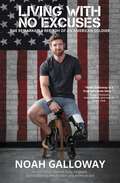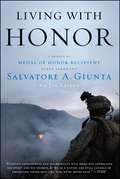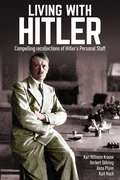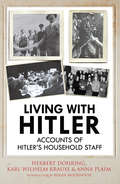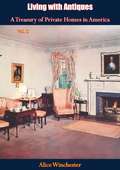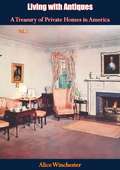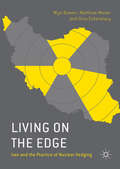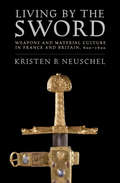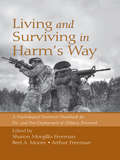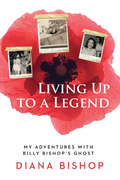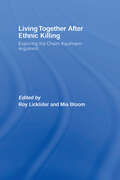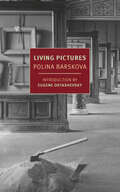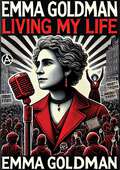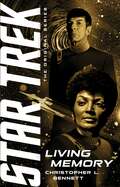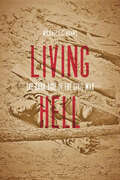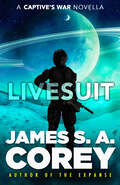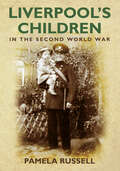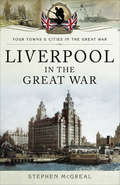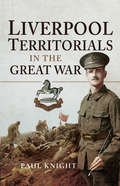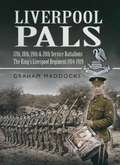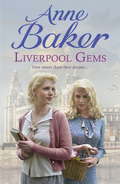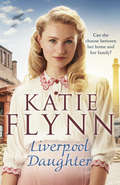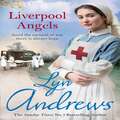- Table View
- List View
Living with No Excuses: The Remarkable Rebirth of an American Soldier
by Noah GallowayMilitary hero and beloved Dancing with the Stars alum Noah Galloway shares his life story, and how losing his arm and leg in combat forced him to relearn how to live--and live to the fullest.Inspirational, humorous, and thought provoking, Noah Galloway's LIVING WITH NO EXCUSES sheds light on his upbringing in rural Alabama, his military experience, and the battle he faced to overcome losing two limbs during Operation Iraqi Freedom. From reliving the early days of life to his acceptance of his "new normal" after losing his arm and leg in combat, Noah reveals his ambition to succeed against all odds. Noah's gripping story is a shining example that with laughter, and the right amount of perspective, you can tackle anything. Whether it be overcoming injury, conquering the Dancing with the Stars ballroom, or taking the next steps forward in life with his young family - Noah demonstrates how to live life to the fullest, with no excuses.
Living with Honor: A Memoir
by Joe Layden Salvatore GiuntaThere was the sound of a single bullet, and then . . . a deafening barrage of gunfire and explosions. There were, literally, thousands of bullets in the air at once, and more tracers streaking across the sky than there were stars overhead. It was a miracle that most of us weren't killed instantly. Staff Sergeant Salvatore, "Sal," Giunta was the first living person to receive the Medal of Honor--the highest honor presented by the U.S. military--since the conclusion of the Vietnam War. In Living with Honor, this hero who maintains he is "just a soldier" tells us the story of the fateful day in Afghanistan that led to his receiving the unique honor. With candor, insight, and humility, Giunta not only recounts the harrowing events leading up to when he and his company fell under siege, but also illustrates the empowering, invaluable lessons he learned. As a seventeen-year-old teen working at Subway, Giunta was like any other kid trying to figure out which step to take next with his life after graduating from high school. When Giunta walked into the local Army recruiting center in his hometown, he just wanted a free T-shirt. But when he walked out, his curiosity had been piqued and he enlisted in the Army. Deployed to Afghanistan, Giunta soon learned from the more seasoned soldiers how "different" this war was compared to others that America had fought. Stationed with the 173rd Airborne Brigade near the Afghanistan-Pakistan border in the Korengal Valley-- also known as the "Valley of Death"--Giunta and his company were ambushed by Taliban insurgents. Giunta went into action after seeing that his squad leader had fallen. Exposing himself to blistering enemy fire, Giunta charged toward his squad leader and administered first aid while he covered him with his own body. Though Giunta was struck by the relentless barrage of bullets, he engaged the enemy and then attempted to reach additional wounded soldiers. When he realized that yet another soldier was separated from his unit, he advanced forward. Discovering two rebels carrying away a U.S. soldier, Giunta killed one insurgent and wounded the other, and immediately provided aid to the injured soldier. More than just a remarkable memoir by a remarkable person, Living with Honor is a powerful testament to the human spirit and all that one can achieve when faced with seemingly impossible obstacles. *** The President clasps the medal around my neck. Applause fills the room. But I know it's not for me alone. I look at my mom and dad. I look at Brennan's parents and I look at Mendoza's. And I try to communicate to Brennan and Mendoza wordlessly: This is for you . . . and for everyone who has fought and died. For everyone who has made the ultimate sacrifice. I am not a hero. I'm just a soldier. --Salvatore A. Giunta, from Living with Honor
Living with Honor
by Joe Layden Sal GiuntaThere was the sound of a single bullet, and then . . . a deafening barrage of gunfire and explosions. There were, literally, thousands of bullets in the air at once, and more tracers streaking across the sky than there were stars overhead. It was a miracle that most of us weren't killed instantly. Staff Sergeant Salvatore, "Sal," Giunta was the first living person to receive the Medal of Honor--the highest honor presented by the U.S. military--since the conclusion of the Vietnam War. In Living with Honor, this hero who maintains he is "just a soldier" tells us the story of the fateful day in Afghanistan that led to his receiving the unique honor. With candor, insight, and humility, Giunta not only recounts the harrowing events leading up to when he and his company fell under siege, but also illustrates the empowering, invaluable lessons he learned. As a seventeen-year-old teen working at Subway, Giunta was like any other kid trying to figure out which step to take next with his life after graduating from high school. When Giunta walked into the local Army recruiting center in his hometown, he just wanted a free T-shirt. But when he walked out, his curiosity had been piqued and he enlisted in the Army. Deployed to Afghanistan, Giunta soon learned from the more seasoned soldiers how "different" this war was compared to others that America had fought. Stationed with the 173rd Airborne Brigade near the Afghanistan-Pakistan border in the Korengal Valley-- also known as the "Valley of Death"--Giunta and his company were ambushed by Taliban insurgents. Giunta went into action after seeing that his squad leader had fallen. Exposing himself to blistering enemy fire, Giunta charged toward his squad leader and administered first aid while he covered him with his own body. Though Giunta was struck by the relentless barrage of bullets, he engaged the enemy and then attempted to reach additional wounded soldiers. When he realized that yet another soldier was separated from his unit, he advanced forward. Discovering two rebels carrying away a U.S. soldier, Giunta killed one insurgent and wounded the other, and immediately provided aid to the injured soldier. More than just a remarkable memoir by a remarkable person, Living with Honor is a powerful testament to the human spirit and all that one can achieve when faced with seemingly impossible obstacles. *** The President clasps the medal around my neck. Applause fills the room. But I know it's not for me alone. I look at my mom and dad. I look at Brennan's parents and I look at Mendoza's. And I try to communicate to Brennan and Mendoza wordlessly: This is for you . . . and for everyone who has fought and died. For everyone who has made the ultimate sacrifice. I am not a hero. I'm just a soldier. --Salvatore A. Giunta, from Living with Honor
Living with Hitler: Compelling recollections of Hitler's Personal Staff
by Karl Wilhelm Krause Herbert Döhring Anna Plaim Kurt KuchThis collection paints a picture of Hitler from members of his household in the unique position of being &“seemingly ever-present, yet totally unconnected to events.&” Compelling recollections from Hitler's Bodyguard Karl Krause (1934-39), his house administrator Herbert Döhring (1935-43) and chambermaid Anna Plaim (1941-43). From these accounts we get a deeper sense of Hitler in close proximity. These accounts massively add to our understanding of Hitler as a three dimensional character, especially from subjects like Plaim who only knew Hitler's home life, having rarely left Berghof. The authors shed light on his likes and dislikes from foods to his hobbies, creating a strange sense of humanity. This collection also provides fresh anecdotes, observations and portraits of Hitler's entourage and relatives. Plaim's images of Eva Braun came from finding torn fragments in the bin, whilst Döhring sheds light on Martin Bormann's demeanour.
Living with Hitler: Accounts of Hitlers Household Staff
by Karl Wilhelm Krause Herbert Döhring Anna PlaimThis collection paints a picture of Hitler from members of his household in the unique position of being seemingly ever-present, yet totally unconnected to events.The reader is introduced to Hitler's Bodyguard Karl Krause (1934-39), his house administrator Herbert Dhring (1935-43) and chambermaid Anna Plaim (1941-43). From these accounts we get a deeper sense of Hitler in close proximity.These accounts massively add to our understanding of Hitler as a three dimensional character, especially from subjects like Plaim who only knew Hitler's home life, having rarely left Berghof.The series is able to shed light on his likes and dislikes from foods to his hobbies, creating a strange sense of humanity. This collection also provides the reader with fresh anecdotes, observations and portraits of Hitler's entourage and relatives. Plaim's images of Eva Braun come from finding torn fragments in the bin, whilst Dhring sheds light on Martin Bormann's demeanour.
Living with Antiques: A Treasury of Private Homes in America Vol. II (Living with Antiques #2)
by Alice WinchesterIN THIS BOOK we have brought together treasures from the past and a wealth of ideas for their use and enjoyment in the present. Like The ANTIQUES Treasury of Furniture and Other Decorative Arts published in 1959, to which it is a companion, this volume is full of information about antiques, but while the previous volume concerned itself with the collections of seven great American museums, this is devoted to American private homes. It makes no recommendations as to what should be done, but it shows what has actually been done by some of America’s most discriminating collectors to bring beauty and also a sense of stability and continuity into their homes. For to these collectors living with antiques does not mean living in the past: it means preserving and enjoying the best of the past in order to add an extra dimension to the present.
Living with Antiques: A Treasury of Private Homes in America Vol. I (Living with Antiques #1)
by Alice WinchesterIN THIS BOOK we have brought together treasures from the past and a wealth of ideas for their use and enjoyment in the present. Like The ANTIQUES Treasury of Furniture and Other Decorative Arts published in 1959, to which it is a companion, this volume is full of information about antiques, but while the previous volume concerned itself with the collections of seven great American museums, this is devoted to American private homes. It makes no recommendations as to what should be done, but it shows what has actually been done by some of America’s most discriminating collectors to bring beauty and also a sense of stability and continuity into their homes. For to these collectors living with antiques does not mean living in the past: it means preserving and enjoying the best of the past in order to add an extra dimension to the present.
Living on the Edge
by Wyn Bowen Dina Esfandiary Matthew MoranIn this book, the authors explore the controversial Iranian nuclear programme through the conceptual lens of nuclear hedging. In 2002, revelations regarding undeclared nuclear facilities thrust Iran's nuclear activities under the spotlight and prompted concerns that Tehran was pursuing nuclear weapons. Iran has always denied nuclear weapons aspirations, yet it cannot be disputed that the Islamic Republic has gone well beyond what is required for a civil nuclear programme based on energy production and scientific research. What, then, is the nature and significance of Iran's nuclear behaviour? Does it form part of a coherent strategy? What can Iran's actions in the nuclear field tell us about Tehran's intentions? And what does the Iranian case teach us about proliferation behaviour more generally? This book addresses these questions by exploring the nature of nuclear hedging and how this approach might be identified, before applying this logic to the Iranian case. It provides fresh insights into the inherently opaque area of nuclear proliferation and a more nuanced interpretation of the Iranian nuclear challenge.
Living by the Sword: Weapons and Material Culture in France and Britain, 600–1600
by Kristen Brooke NeuschelSharpen your knowledge of swords with Kristen B. Neuschel as she takes you through a captivating 1,000 years of French and English history. Living by the Sword reveals that warrior culture, with the sword as its ultimate symbol, was deeply rooted in ritual long before the introduction of gunpowder weapons transformed the battlefield.Neuschel argues that objects have agency and that decoding their meaning involves seeing them in motion: bought, sold, exchanged, refurbished, written about, displayed, and used in ceremony. Drawing on evidence about swords (from wills, inventories, records of armories, and treasuries) in the possession of nobles and royalty, she explores the meanings people attached to them from the contexts in which they appeared. These environments included other prestige goods such as tapestries, jewels, and tableware—all used to construct and display status.Living by the Sword draws on an exciting diversity of sources from archaeology, military and social history, literature, and material culture studies to inspire students and educated lay readers (including collectors and reenactors) to stretch the boundaries of what they know as the "war and culture" genre.
Living and Surviving in Harm's Way: A Psychological Treatment Handbook for Pre- and Post-Deployment of Military Personnel
by Arthur Freeman Sharon Morgillo Freeman Bret A MooreIn Living and Surviving in Harm's Way, experts investigate the psychological impact of how warriors live and survive in combat duty. They address the combat preparation of servicemen and women, their support systems, and their interpersonal and intrapersonal experiences. The text maintains a focus on cognitive-behavioral interventions for treating various combat-related disorders, and addresses psychological health and adjustment after leaving the battlefield. The text is logically organized for easy reading and reference, and covers often overlooked topics such as preparation and training of service personnel, women in combat, and the indirect effects of combat stress on family. This book is written by clinicians who have in some ways experienced what they write about, and resonates with mental health professionals, servicemen and women, and their families. Any clinician hoping to treat a serviceman or woman effectively cannot afford to overlook this book.
Living Up to a Legend: My Adventures with Billy Bishop's Ghost
by Diana BishopDiana Bishop recounts growing up in the shadow of her famous grandfather, Canadian First World War flying ace Billy Bishop. As a child, Diana Bishop showed up one day at school with a brown paper bag. Inside was a large breastplate of some of the most precious war medals on the planet, including the Victoria Cross. They belonged to Canada’s most celebrated First World War pilot, Billy Bishop, and until her family donated them to the Canadian War Museum, they had been kept in her father’s underwear drawer. That day at school was the first time Diana realized she was not growing up in an ordinary family. Now, after more than two decades in Canadian media, Diana Bishop looks back on her grandfather’s legacy and its profound influence over her life, and also her father’s — the only son of Billy Bishop, who had so much to live up to. Living Up to a Legend is a unique memoir that covers Billy Bishop’s legacy through the eyes of one of the people who it affected the most.
Living Together After Ethnic Killing: Exploring the Chaim Kaufman Argument
by Mia Bloom Roy LickliderThis volume attempts to critically analyze Chaim Kaufman's ideas from various methodological perspectives, with the view of further understanding how stable states may arise after violent ethnic conflict and to generate important debate in the area. After the Cold War, the West became optimistic of their ability to intervene effectively in instances of humanitarian disasters and civil war. Unfortunately, in the light of Bosnia, Somalia and Rwanda, questions of the appropriate course of action in situations of large scale violence became hotly contested. A wave of analysis considered the traditional approach of third parties attempting to ensure that the nation was built on the basis of a ruling power-share between the opposing sides of the conflict to be overwhelmingly problematic, and perhaps impossible. Within this movement Kaufman wrote a series of articles advocating separation of warring sides in order to provide stability in situations of large scale violence. His theorem provoked extreme responses and polarized opinion, contradicting the established position of promoting power-sharing, democracy and open economies to solve ethnic conflict and had policy implications for the entire international community. This book was previously published as a special issue of Security Studies.
Living Pictures
by Polina BarskovaA poignant collection of short pieces about the author's hometown, St. Petersburg, Russia, and the siege of Leningrad that combines memoir, history, and fiction.Living Pictures refers to the parlor game of tableaux vivants, in which people dress up in costume to bring scenes from history back to life. It&’s a game about survival, in a sense, and what it means to be a survivor is the question that Polina Barskova explores in the scintillating literary amalgam of Living Pictures. Barskova, one of the most admired and controversial figures in a new generation of Russian writers, first made her name as a poet; she is also known as a scholar of the catastrophic siege of Leningrad in World War II. In Living Pictures, Barskova writes with caustic humor and wild invention about traumas past and present, historical and autobiographical, exploring how we cope with experiences that defy comprehension. She writes about her relationships with her adoptive father and her birth father; about sex, wanted and unwanted; about the death of a lover; about Turner and Picasso; and, in the final piece, she mines the historical record in a chamber drama about two lovers sheltering in the Hermitage Museum during the siege of Leningrad who slowly, operatically, hopelessly, stage their own deaths.Living Pictures introduces a startlingly daring and original new voice from world literature.
Living My Life: The Autobiography of a Social Activist, Women’s Rights Campaigner and Political Philosopher
by Emma GoldmanStep into the passionate and tumultuous world of one of history's most iconic anarchists with Emma Goldman’s powerful autobiography, "Living My Life." This riveting two-volume memoir offers an unflinching account of Goldman's life, from her early years in Russia to her rise as a leading figure in the anarchist movement in the United States and beyond.Emma Goldman, renowned for her fiery oratory and uncompromising activism, provides a deeply personal narrative that intertwines her political beliefs with her personal experiences. "Living My Life" chronicles her relentless fight for social justice, free speech, and workers' rights, painting a vivid picture of her involvement in pivotal historical events, including the Haymarket affair, the rise of the labor movement, and the fight for women's emancipation.Through Goldman's eloquent prose, readers gain insight into the challenges and triumphs she faced as a radical thinker and activist. She candidly discusses her relationships, her encounters with prominent figures like Alexander Berkman and Peter Kropotkin, and her multiple imprisonments and deportations. Goldman's reflections on her life's work provide a poignant look at the sacrifices and resilience required to pursue a vision of a more equitable world."Living My Life" is not just a historical document but also a testament to the enduring spirit of resistance and the quest for freedom. Goldman's narrative is imbued with a profound sense of humanity, capturing her unwavering dedication to her principles and her unyielding belief in the power of individual and collective action.This autobiography is essential reading for anyone interested in the history of social movements, anarchism, and feminist thought. Emma Goldman's "Living My Life" remains a compelling and inspirational work that continues to resonate with readers seeking to understand the complexities of social change and the indomitable will of those who fight for it. Immerse yourself in Emma Goldman’s extraordinary journey and discover the life of a woman who defied conventions, challenged injustices, and left an indelible mark on the world.
Living Memory (Star Trek: The Original Series)
by Christopher L. BennettAn all-new Star Trek movie-era adventure!While attempting to settle in as commandant of Starfleet Academy, Admiral James T. Kirk must suddenly contend with the controversial, turbulent integration of an alien warrior caste into the student body—and quickly becomes embroiled in conflict when the Academy controversy escalates to murder. Meanwhile, Captain Spock of the USS Enterprise and Commander Pavel Chekov of the USS Reliant are investigating a series of powerful cosmic storms seemingly targeting Federation worlds—unstoppable outbursts emitting from the very fabric of space. Endeavoring to predict where the lethal storms will strike next, Spock and Chekov make the shocking discovery that the answer lies in Commander Nyota Uhura&’s past—one that she no longer remembers…. ™, ®, & © 2021 CBS Studios, Inc. STAR TREK and related marks and logos are trademarks of CBS Studios, Inc. All Rights Reserved.
Living Hell: The Dark Side of the Civil War
by Michael C. AdamsA senior military historian presents an unflinching account of the human costs of the Civil War.Many Americans, argues Michael C. C. Adams, tend to think of the Civil War as more glorious, less awful, than the reality. Millions of tourists flock to battlefields each year as vacation destinations, their perceptions of the war often shaped by reenactors who work hard for verisimilitude but who cannot ultimately simulate mutilation, madness, chronic disease, advanced physical decay. In Living Hell, Adams tries a different tack, clustering the voices of myriad actual participants on the firing line or in the hospital ward to create a virtual historical reenactment.Perhaps because the United States has not seen conventional war on its own soil since 1865, the collective memory of its horror has faded, so that we have sanitized and romanticized even the experience of the Civil War. Neither film nor reenactment can fully capture the hard truth of the four-year conflict. Living Hell presents a stark portrait of the human costs of the Civil War and gives readers a more accurate appreciation of its profound and lasting consequences.Adams examines the sharp contrast between the expectations of recruits versus the realities of communal living, the enormous problems of dirt and exposure, poor diet, malnutrition, and disease. He describes the slaughter produced by close-order combat, the difficulties of cleaning up the battlefields—where tens of thousands of dead and wounded often lay in an area of only a few square miles—and the resulting psychological damage survivors experienced.Drawing extensively on letters and memoirs of individual soldiers, Adams assembles vivid accounts of the distress Confederate and Union soldiers faced daily: sickness, exhaustion, hunger, devastating injuries, and makeshift hospitals where saws were often the medical instrument of choice. Inverting Robert E. Lee’s famous line about war, Adams suggests that too many Americans become fond of war out of ignorance of its terrors. Providing a powerful counterpoint to Civil War glorification, Living Hell echoes William Tecumseh Sherman’s comment that war is cruelty and cannot be refined.Praise for Our Masters the Rebels: A Speculation on Union Military Failure in the East, 1861–1865"This excellent and provocative work concludes with a chapter suggesting how the image of Southern military superiority endured in spite of defeat."—Civil War History"Adams's imaginative connections between culture and combat provide a forceful reminder that Civil War military history belongs not in an encapsulated realm, with its own categories and arcane language, but at the center of the study of the intellectual, social, and psychological currents that prevailed in the mid-nineteenth century."—Journal of American HistoryPraise for The Best War Ever: America and World War II"Adams has a real gift for efficiently explaining complex historical problems."—Reviews in American History"Not only is this mythologizing bad history, says Adams, it is dangerous as well. Surrounding the war with an aura of nostalgia both fosters the delusion that war can cure our social ills and makes us strong again, and weakens confidence in our ability to act effectively in our own time."—Journal of Military History
Livesuit (The Captive's War)
by James S. CoreyThe first novella set in the universe of James S. A. Corey's epic Captive's War series. Humanity's war is eternal, spread across the galaxy and the ages. Humanity's best hope to end the endless slaughter is the Livesuit forces. Soldiers meld their bodies to the bleeding edge technology, becoming something more than human for the duration of a war that might never end. For more from James S. A. Corey, check out: The Captive&’s War: The Mercy of GodsThe Expanse: Leviathan Wakes Caliban&’s War Abaddon&’s Gate Cibola Burn Nemesis Games Babylon&’s Ashes Persepolis Rising Tiamat&’s Wrath Leviathan Falls Memory&’s Legion The Expanse Short Fiction: Drive The Butcher of Anderson Station Gods of Risk The Churn The Vital Abyss Strange Dogs Auberon The Sins of Our Fathers
Liverpool's Children in the Second World War
by Pamela RussellThis is the untold story of Liverpool's children in the Second World War. Whilst everyone is familiar with the tales of evacuees who were rushed out of the cities once the bombs started falling, many of us are unaware that many stayed behind, either by choice or necessity, as the city of their childhood disintegrated and burned around them. In the words of those who experienced the Liverpool Blitz first-hand, we hear of their adventures and misadventures, the fun and games and ever-present danger, and the humor and sorrow of those wartime years. This is an important and revealing look at the war as seen through the eyes of these children. This book not only explores the memories of a childhood ravaged by war, but also the formative effect this had on individuals' lives. It reflects the collective spirit of a city that refused to be crushed, even at the darkest hours of the Luftwaffe's bombing campaign. Ideal for anyone who lived through those times, or who is fascinated by experiences and the legacy of the wartime generation, this new title pays tribute to the war's forgotten children.
Liverpool in the Great War (Your Towns & Cities in the Great War)
by Stephen McGrealAt the dawn of the twentieth century Liverpool had 8 miles of docks thronged with cargo ships loading or discharging goods. When Britain declared war on Germany in the summer of 1914, Liverpool's geographical position demanded it be one of the chief home bases for wartime operations. It was a challenge the city accepted with relish and went on to become one of the most significant home-front contributors to the Allied victory. Justifiable, the city cenotaph proudly declares 'out of the north parts came a great company and a mighty army', but there is a forgotten army of patriotic civilians whose endeavours played a key role in the Allied victory. Despite an acute shortage of skilled labour, Liverpool led the way in the construction of munition factories and developed the required skills to 'feed the guns'. Inititally, men who were too old for military service produced shells, but a local factory became the first in the country to introduce women shell-makers, and this initiative was replicated throughout the nation As the men made the transition from street to trench, Liverpool and district developed into a vast arsenal employing approximately 30,000 women and producing a million shells a month. Civilians were also actively involved in tending the wounded, fund-raising for hospital equipment and ambulances and the provisions of home comforts for those at the front. When the German submarine onslaught almost severed Britain's maritime trade routes food rationing was introduced. Damaged ships limped into Liverpool were ploughed up as the nation 'dug for victory'. The city was also a portal through which thousands of American troops passed; they stayed briefly at Springfield Park Rest Camp before entraining south. This is the fascinating but largely forgotten story of how Liverpool provided the sinews of war.
Liverpool Territorials in the Great War
by Paul KnightThe Territorial Force is the forgotten army of the First World War. Between the pre-war Regular Army, which attempted to stem the German advance in 1914, and the New Armies who took to the field with such disastrous consequences on the Somme in 1916, stood the Territorial Army. Liverpool's Territorials could be found on the Western Front before the famous Christmas truce of 1914, fighting in Gallipoli, and supporting the Canadians. Throughout 1916 and 1917, they succeeded and failed in some of the most brutal battles of the war. During the German 1918 Spring Offensive, Liverpool Territorials in the 55th (West Lancashire) Division halted the German advance, effectively ending Germany's final bid to win the war.Amazingly, the Territorials were never intended, trained, or equipped for overseas service; their role was to defend the UK mainland against invasion. Yet men across Liverpool's diverse communities volunteered for the Territorials in the thousands, forming the core of two divisions during the war.Formed in 1908, but building on the Volunteer tradition of the 1850s, the Territorials remain in Liverpool to this day. Renamed the Army Reserve, they are still training and volunteering for operations.Offering a fresh, integrated perspective on the Territorial Army during the First World War, this is the remarkable story of the Liverpool Territorials.
Liverpool Pals: 17th, 18th, 19th, 20th Service Battalions, The King's Liverpool Regiment 1914-1919 (Pals Ser.)
by Graham MaddocksLiverpool Pals, is a record of duty, courage and endeavour of a group of men who, before war broke out in 1914, were the backbone of Liverpool's commerce. Fired with patriotism, over 4,000 of these businessmen volunteered in 1914 and were formed into the 17th, 18th, 19th and 20th (Service) Battalions of the King's (Liverpool Regiment); they were the first of all the Pals battalions to be raised, and they were the last to be stood down. It is commonly held that the North of England's Pals battalions were wiped out on the 1st July, 1916, certainly this befell a number of units, but the Liverpool Pals took all their objectives on that day. From then on they fought all through the Somme Battle, The Battle of Arras and the muddy hell of Passchendaele in 1917, and the desperate defence against the German offensive of March 1918.
Liverpool Gems: Twin sisters chase their dreams…
by Anne BakerWhile in pursuit of independence and love, a young woman finds her family needs her more than ever. Liverpool Gems is a dramatic and warm-hearted Liverpool saga from Anne Baker, which is sure to appeal to fans of Katie Flynn and Lyn Andrews.It is 1935 and as Carrie Courtney watches her twin sister, Connie, marry the man of her dreams, Carrie longs to find a love of her own. Having lost their mother at an early age, the girls were brought up by their maiden aunts and, with Connie leaving home, Carrie is desperate to spread her wings.Using her skills as a bookkeeper, Carrie gets an exciting new job but her stunning beauty soon attracts the wrong kind of attention. And romance is the last thing on her mind when her beloved father finds himself caught up in an illegal jewellery business that threatens to destroy them all... What readers are saying about Liverpool Gems: 'Quite a page turner like most of Anne's books, she keeps the reader gripped from the first page, excellent writing''Anne Baker never fails to please her fans, loved this and highly recommend'
Liverpool Daughter: A heart-warming wartime story from the Sunday times bestselling author (The Liverpool Sisters #1)
by Katie FlynnTHE FIRST NOVEL IN A HEART-WARMING NEW SERIES BY SUNDAY TIMES BESTSELLER, KATIE FLYNN______________________________'Home is where the heart is, and my heart belongs to Liverpool. We would not dream of leavin' our beloved cit . .'August 1940: As the Luftwaffe swarm over Liverpool, Shane Quinn decides to move his family back to the safety of Ireland. But his only child, the beautiful Dana, would rather stay and serve her country than flee to a foreign land.Determined to make it on her own, she joins the WAAF with newfound pals Patty and Lucy. There is plenty of excitement to be had on a RAF station, and even a chance or two at love.But the stark reality of war begins to take its toll and the three girls soon discover they need their friendship more than ever. And when shocking news arrives from Ireland, Dana will realise the true importance of family.______________________________Praise for Katie Flynn:'If you pick up a Katie Flynn book it's going to be a wrench to put it down again' Holyhead and Anglesey Mail'Packed with romance and poignancy' Woman'One of the best Liverpool writers' Liverpool Echo'Heart-warming' Take a Break
Liverpool Angels: A completely gripping saga of love and bravery during WWI
by Lyn AndrewsBravery and fortitude are essential for two young nurses to survive the Great War... Lyn Andrews' saga, Liverpool Angels, is a haunting and unforgettable tale of nursing in the battlefields of the First World War. Perfect for fans of Nadine Dorries and Maureen Lee.Born at the turn of the twentieth century, Mae Strickland is only a few days old when her mother suddenly dies. Her aunt Maggie brings Mae up together with her own children, Eddie and Alice, and the girls become like sisters. In spite of Mae's unhappy start, life feels full of promise.Then, as the First World War looms, everything changes. While the local men - including young Eddie - leave to fight, Mae and Alice train as field nurses. As they travel to the front line in the wake of family tragedy, nothing can prepare them for the hardship that lies ahead.Yet there is solace to be found amid the wreckage of the war, and for both, romance is on the horizon. But it will take great courage for Mae and Alice to follow their hearts. Can love win out in the end? What Amazon readers are saying about Liverpool Angels: 'As in all of Lyn Andrews' books that I've read, she has a great talent for weaving emotion into her writing. You feel connected to her characters, and get really invested in their lives and their struggles''The research that Lyn has put into this book is wonderful, it has so much detail and depth as if she has experienced this first hand. You can really get deep into the story and feel as if you are experiencing it with Alice and Mae''Well written, believable and emotive'
Liverpool Angels: A completely gripping saga of love and bravery during WWI
by Lyn AndrewsLyn Andrews' tale of nursing in the field during World War I is haunting and unforgettable. If you enjoy the novels of Kate Thompson and Donna Douglas, you'll love LIVERPOOL ANGELS. Born at the turn of the twentieth century, Mae Strickland is only a few days old when her mother suddenly dies. Her aunt Maggie brings Mae up together with her own children, Eddie and Alice, and the girls become like sisters. In spite of Mae's unhappy start, life feels full of promise.Then, as the First World War looms, everything changes. While the local men - including young Eddie - leave to fight, Mae and Alice train as field nurses. As they travel to the front line in the wake of family tragedy, nothing can prepare them for the hardship that lies ahead.Yet there is solace to be found amid the wreckage of the war, and for both, romance is on the horizon. But it will take great courage for Mae and Alice to follow their hearts. Can love win out in the end?(P)2013 Headline Digital
